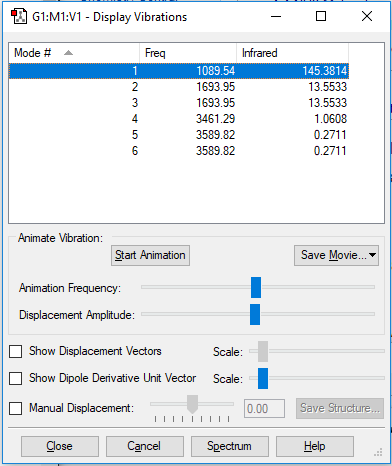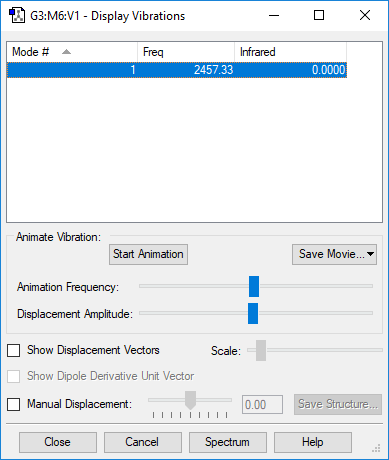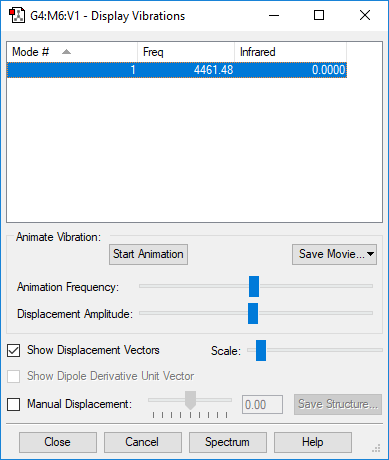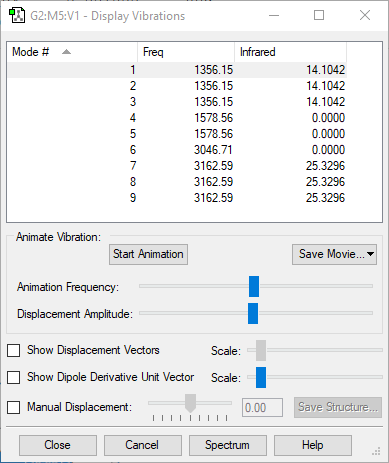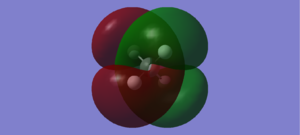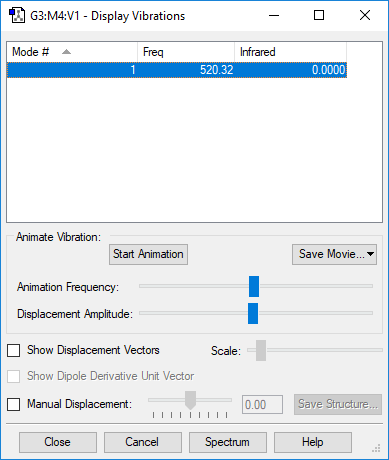Rep:Mod:HYM0217
NH 3 Molecule
Summary Information
Calculation method: RB3LYP
Basis set: 6-31G(d.p)
Final energy E(RB3LYP): -56.55776873 a.u.
RMS gradient: 0.00000485 a.u.
Point group: C3V
"Item" Section in Log File
Item Value Threshold Converged? Maximum Force 0.000004 0.000450 YES RMS Force 0.000004 0.000300 YES Maximum Displacement 0.000072 0.001800 YES RMS Displacement 0.000035 0.001200 YES
Jmol of Structure
ammonia |
Key Structural Information
N-H bond length: 1.02 Å
H-N-H bond angle: 106° Å
The optimisation file is linked here
Display Vibrations Table
Table of Vibrations and Intensities
| mode number | 1 | 2 | 3 |
| wavenumber (cm-1) | 1090 | 1694 | 1694 |
| symmetry | A1 | E | E |
| intensity (arbitrary units) | 145 | 14 | 14 |
| image |  |
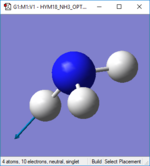 |
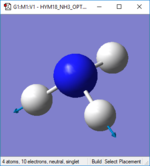
|
| mode number | 4 | 5 | 6 |
| wavenumber (cm-1) | 3461 | 3590 | 3590 |
| symmetry | A1 | E | E |
| intensity (arbitrary units) | 1 | 0 | 0 |
| image |  |
 |

|
Vibrational Analysis
how many modes do you expect from the 3N-6 rule?
3
which modes are degenerate (ie have the same energy)?
Modes 2 and 3 are degenerate as well as modes 5 and 6.
which modes are "bending" vibrations and which are "bond stretch" vibrations?
Modes 1,2 and 3 are "bending" vibrations. Modes 4,5 and 6 are "bond stretch" vibrations.
which mode is highly symmetric?
Mode 4
one mode is known as the "umbrella" mode, which one is this?
Mode 1
how many bands would you expect to see in an experimental spectrum of gaseous ammonia?
3
Charge Analysis
Expectation: I would expect N to have a negative charge and H to have a positive charge because N is more electronegative than H.
Results: Charge on the N-atom was -1.125 and charge on the H-atoms were 0.375.
N2 Molecule
Summary Information
Calculation method: RB3LYP
Basis set: 6-31G(d.p)
Final energy E(RB3LYP): -109.52412868 a.u.
RMS gradient: 0.00000001 a.u.
Point group: Dinfh
"Item" Section in Log File
Item Value Threshold Converged? Maximum Force 0.244453 0.000450 NO RMS Force 0.244453 0.000300 NO Maximum Displacement 0.125611 0.001800 NO RMS Displacement 0.177641 0.001200 NO
Jmol of the Structure
nitrogen |
Key Structural Information
The optimisation file is linked here
NΞN bond length: 1.11 Å
Display Vibrations Table
Table of Vibrations and Intensities
| mode number | 1 |
| wavenumber (cm-1) | 2457 |
| symmetry | SGG |
| intensity (arbitrary units) | 0 |
Charge Analysis
Expectation: I would expect both N-atoms to have no charge as the two atoms are the same so have the same electronegativities.
Results: Charge on the N-atoms were 0.000
H2 Molecule
Summary Information
Calculation method: RB3LYP
Basis set: 6-31G(d.p)
Final energy E(RB3LYP): -1.17853930 a.u.
RMS gradient: 0.00012170 a.u.
Point group: Dinfh
"Item" Section of Log File
Item Value Threshold Converged? Maximum Force 0.095055 0.000450 NO RMS Force 0.095055 0.000300 NO Maximum Displacement 0.150000 0.001800 NO RMS Displacement 0.212132 0.001200 NO
Jmol of Structure
hydrogen |
Key Structural Information
H-H bond length: 0.74 Å
The optimisation file is linked here
Display Vibrations Table
Table of Vibrations and Intensities
| mode number | 1 |
| wavenumber (cm-1) | 4461 |
| symmetry | SGG |
| intensity (arbitrary units) | 0 |
Charge Analysis
Expectation: I would expect both H-atoms to have no charge as the two atoms are the same so have the same electronegativities.
Results: Charge on the H-atoms were 0.000
Mono-metallic TM complex that coordinates N2
The unique identifier code for the structure is VEJSEL and a link to the structure is here:[1]
The N-N distance is 1.13 Å for the crystal structure.
The difference between experimental and computational bond length is larger the smaller the mass of the atoms bonded together. The difference between the two values comes about because of anharmonicity, where the weighted average of the bond length over the vibration is not centered at the computed equilibrium bond distance, but at a longer distance. This means that the computational bond length will in most cases be shorter than the experimental bond length. Hence the crystal structure N-N distance is 0.02 Å greater than the computational N-N distance.
Energy for the Haber-Bosch process
E(NH3)= -56.5577687 a.u.
2*E(NH3)= -113.1155374 a.u.
E(N2)= -109.5241287 a.u.
E(H2)= -1.1785393 a.u.
3*E(H2)= -3.5356179 a.u.
ΔE = energy for converting hydrogen and nitrogen gas into ammonia gas = 2*E(NH3)-[E(N2)+3*E(H2)] = -0.0557908 a.u. = -0.0557908 x 2625.5 kJ/mol = -146.5 kJ/mol (to 1 d.p.)
The reaction is exothermic therefore the ammonia product is more stable as the total energy of the products is lower than the total energy of the reactants.
CH 4 Molecule
Summary Information
Calculation method: RB3LYP
Basis set: 6-31G(d.p)
Final energy E(RB3LYP): -40.52401405 a.u.
RMS gradient: 0.00002267 a.u.
Point group: Td
"Item" Section of Log File
Item Value Threshold Converged? Maximum Force 0.000044 0.000450 YES RMS Force 0.000023 0.000300 YES Maximum Displacement 0.000124 0.001800 YES RMS Displacement 0.000066 0.001200 YES
Jmol of Structure
methane |
Key Structural Information
C-H bond length: 1.09 Å
H-C-H bond angle: 109° Å
The optimisation file is linked here
Display of Vibrations
Table of Vibrations and Intensities
| mode number | 1 | 2 | 3 | 4 | 5 |
| wavenumber (cm-1) | 1356 | 1356 | 1356 | 1579 | 1579 |
| symmetry | T2 | T2 | T2 | E | E |
| intensity (arbitrary units) | 14 | 14 | 14 | 0 | 0 |
| image | 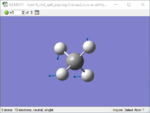 |
 |
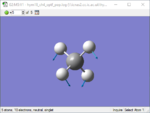 |
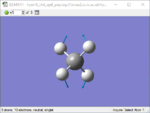 |
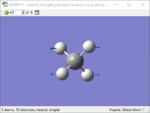
|
| mode number | 6 | 7 | 8 | 9 |
| wavenumber (cm-1) | 3047 | 3163 | 3163 | 3163 |
| symmetry | A1 | T2 | T2 | T2 |
| intensity (arbitrary units) | 0 | 25 | 25 | 25 |
| image | 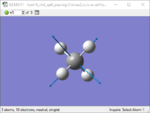 |
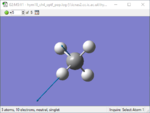 |
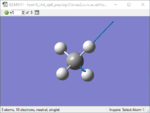 |
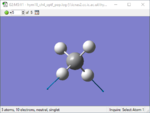
|
Vibrational Analysis
how many modes do you expect from the 3N-6 rule?
9
which modes are degenerate (ie have the same energy)?
Modes 1,2 and 3 are degenerate as well as modes 5 and 6. Modes 7, 8 and 9 are also degenerate.
which modes are "bending" vibrations and which are "bond stretch" vibrations?
Modes 1, 2, 3, 4 and 5 are "bending" vibrations. Modes 6, 7, 8 and 9 are "bond stretch" vibrations.
Charge Analysis
Expectation: I would expect C to have a negative charge and H to have a positive charge because C is more electronegative than H.
Results: Charge on the C-atom was -0.930 and charge on the H-atoms were 0.233.
Molecular Orbitals
Cl2 molecule
Summary Information
Calculation method: RB3LYP
Basis set: 6-31G(d.p)
Final energy E(RB3LYP): -920.34987886
RMS gradient: 0.00002511 a.u.
Point group: Dinfh
"Item" Section in Log File
Item Value Threshold Converged? Maximum Force 0.000043 0.000450 YES RMS Force 0.000043 0.000300 YES Maximum Displacement 0.000121 0.001800 YES RMS Displacement 0.000172 0.001200 YES
Jmol of Structure
chlorine |
Key Structural Information
Cl-Cl bond length: 2.04 Å
The optimisation file is linked here
Display Vibrations Table
Table of Vibrations and Intensities
| mode number | 1 |
| wavenumber (cm-1) | 520 |
| symmetry | SGG |
| intensity (arbitrary units) | 0 |
| image | 
|
Charge Analysis
Expectation: I would expect both Cl-atoms to have no charge as the two atoms are the same so have the same electronegativities.
Results: Charge on the Cl-atoms were 0.000
Marking
Note: All grades and comments are provisional and subject to change until your grades are officially returned via blackboard. Please do not contact anyone about anything to do with the marking of this lab until you have received your grade from blackboard.
Wiki structure and presentation 1/1
Is your wiki page clear and easy to follow, with consistent formatting?
YES
Do you effectively use tables, figures and subheadings to communicate your work?
YES
NH3 0.5/1
Have you completed the calculation and given a link to the file?
YES
Have you included summary and item tables in your wiki?
YES
Have you included a 3d jmol file or an image of the finished structure?
YES
Have you included the bond lengths and angles asked for?
YES
Have you included the “display vibrations” table?
YES
Have you added a table to your wiki listing the wavenumber and intensity of each vibration?
YES
Did you do the optional extra of adding images of the vibrations?
YES
Have you included answers to the questions about vibrations and charges in the lab script?
YES
From the 3N-6 rule 6 vibrations are expected, not three. For NH3 N=4, so 3*4-6=12-6=6. You correctly identified two pairs of degenerate vibrations which explains a spectrum with 4 bands. The intensities of the stretching vibrations are too low to be observed in an experimental spectrum, so only 2 bands will be observed.
N2 and H2 0.5/0.5
Have you completed the calculations and included all relevant information? (summary, item table, structural information, jmol image, vibrations and charges)
YES
Crystal structure comparison 0.5/0.5
Have you included a link to a structure from the CCDC that includes a coordinated N2 or H2 molecule?
YES
Have you compared your optimised bond distance to the crystal structure bond distance?
YES
Haber-Bosch reaction energy calculation 1/1
Have you correctly calculated the energies asked for? ΔE=2*E(NH3)-[E(N2)+3*E(H2)]
YES
Have you reported your answers to the correct number of decimal places?
YES
Do your energies have the correct +/- sign?
YES
Have you answered the question, Identify which is more stable the gaseous reactants or the ammonia product?
YES
Your choice of small molecule 4/5
Have you completed the calculation and included all relevant information?
YES
Have you added information about MOs and charges on atoms?
YES
Vibrational modes 5 and 6 are not degenerate! Modes 4 and 5 are degenerate instead. You correctly identified contributing AOs and the influence on bonding of MOs. You could have analysed the relative MO energies in more detail and give more then the minimal information you extracted from the output files.
Independence 1/1
If you have finished everything else and have spare time in the lab you could:
Check one of your results against the literature, or
Do an extra calculation on another small molecule, or
YES - You could have analysed these data in more detail.
Do some deeper analysis on your results so far

